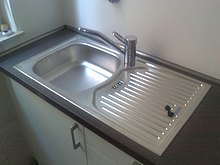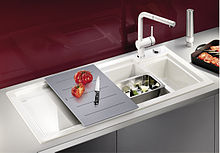Sink
A sink (coll. And sink ) (in Austria, "the washing up " in Switzerland mainly " kitchen sink ") is usually embedded in the plate of the kitchen work surface and is, for the preparation of foods (. As cleaning of fruit, salad or Vegetables) and used to clean dishes and kitchen materials. The difference to the wash basin is hygienic in nature, while colloquially these are often no longer differentiated. While lubricants are sometimes used in sinks, for example, it is a subjective question to what extent one would like to process them together with food. Rubbish stones already existed in the Middle Ages, but mostly only in castles or palaces. Colloquially in some regions (eg. As the Rhineland) customary term sink for the kitchen sink still comes from this.
The sink, along with the stove and refrigerator, are part of the basic equipment of a modern kitchen. The sink is usually equipped with a kitchen faucet and is therefore the central point for supplying the kitchen with hot and cold water. In the Franconian-speaking area, the second basin is also known as the Abfleibecken.
Sink concepts
A distinction is made between single and multi-basin sinks. The latter have a smaller additional basin and / or a second full-fledged main basin to enable parallel operations such as pouring out leftovers or washing vegetables. Since most households have a dishwasher, larger items, e.g. B. baking trays, cutting boards or woks , a spacious main bowl with a large bowl diagonal is particularly advantageous. Often sinks are combined with a draining board in order to return dripping water to the sink.
Round bowl sinks are mostly designed as single bowl sinks with comparatively small sinks. Corner sinks are special solutions for corner base units.
In Germany, sinks must be equipped with an overflow to prevent accidental flooding of the kitchen; in other countries, sinks without an overflow are also permitted.
For gastronomy , sinks are standardized in DIN 66075-5 ( Gastro-Norm : facilities for gastronomy; sinks, dimensions; edition 1975-07).
materials
The most popular material for sinks is chrome-nickel steel , a rust-free stainless steel. The so-called stainless steel sinks have been available since the 1950s in different material specifications (for example DIN 1.4301). The surfaces of the sinks can be smooth, but they are also available with a wide variety of embossed surfaces, for example linen structure, which hides the sensitivity of the material to scratches. Simpler stainless steel sinks are deep-drawn from sheet metal in one piece , more sophisticated products are created by joining, for example welding several deep-drawn parts or sheet metal blanks.
Kitchen sinks made from composite materials have been around since the early 1980s . They are offered in many colors and shapes. High-quality products are usually extremely scratch-resistant and easy to care for and can withstand temperatures of up to 280 ° C and all normal kitchen stresses (for example strongly coloring foods or acids). Modern production processes also enable filigree shapes that cannot be realized with other materials.
For many decades, kitchen sinks have been made from the traditional materials ceramics and stoneware .
Another material that was used more frequently in the past is terrazzo , but today it is only used for particularly exclusive pools. The disadvantage is the relatively large weight, which requires a correspondingly stable substructure.
Natural stone has become largely irrelevant as a material for sinks because many stone materials such as marble are not resistant enough or no longer meet today's hygienic requirements, such as sandstone that absorbs liquids .
Glass is mostly combined with other materials. In most cases, stainless steel basins are connected to a horizontal glass work area.
Enamelled steel is now of little importance as a sink material. It stands for the beginnings of colored kitchen sinks, which have been replaced by more comfortable and durable products made of composite material or colored ceramics since the eighties, as the enamel can easily split off when hit.
Installation types
In most countries around the world, the majority of sinks are marketed as built-in sinks and inserted into the previously cut worktop in the classic way. With this installation method, the edge of the sink rests on the worktop, and the sink is fixed with screw fasteners or glue.
Sink modules and countertop basins are also mounted from above onto the worktop or the sink base unit, but their design makes them ideal for architecturally sophisticated kitchen designs.
With flush installation, the edge of the sink is let into the worktop. The sink and worktop are on the same level, the edge of the sink does not form a barrier in contrast to conventional installation, so that the entire work area is extremely easy to clean.
In the substructure, the basins or sinks are mounted under a worktop made of water-resistant material such as natural stone, concrete, composite material or glass. With this installation method, the kitchen faucet is often installed directly on the worktop, some suppliers also offer undermount basins with an integrated battery bank.
Lay-on sinks are simple sinks made of stainless steel that are placed on and attached to a sink cabinet.
equipment
The kitchen faucet is the most important complementary component of a kitchen sink. The faucet can often be attached directly to the sink; faucets for wall mounting are rather rare.
A distinction is made between fittings with a pipe outlet and pull-out hose shower or versions for high and low pressure. Special fittings in front of the window can be lowered or removed so that a kitchen sink can also be placed in front of windows with low parapets.
In many countries, a waste system is installed in the cupboard under the kitchen sink. The solutions range from simple garbage collectors to systems with several bins that enable waste to be separated as required. In some states or regions, rubbish grinders are approved that are mounted on the sink outlet and grind the organic waste and dispose of it in the sewer system. This option of disposing of compostable waste is not permitted in Germany.
Web links
Individual evidence
- ↑ Thomas Laasch, Erhard Laasch: House technology: Basics - planning - execution . ISBN 3-8348-9900-3 , pp. 16 ( limited preview in Google Book search).



